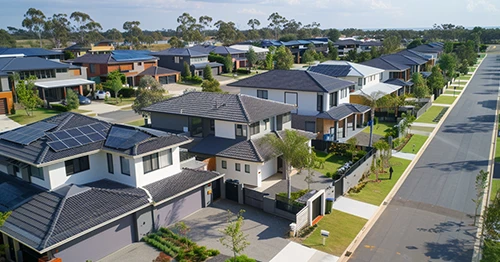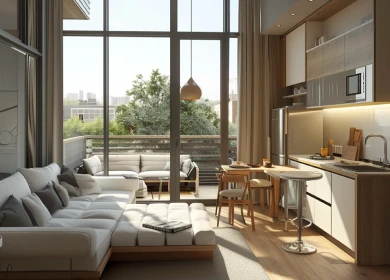Updated: 12 Jul, 2024
The findings from the latest ANZ CoreLogic Housing Affordability Report found a deterioration in housing affordability due to rapid increases in house prices and rental costs. The report analysed housing affordability in the March 2022 quarter based on four metrics:
- Dwelling value-to-household income ratio
- Years required to save a 20% deposit
- The portion of income required to service a new mortgage
- The portion of income required to service rent
| Details | Value to income | Years to save a deposit | Portion of income to service a new mortgage | Portion of income to pay rent |
|---|---|---|---|---|
| National | 8.5 | 11.4 | 41.4% | 30.6% |
| Combined capitals | 8.4 | 11.2 | 40.9% | 28.0% |
| Combined regions | 7.9 | 10.5 | 38.3% | 34.0% |
| Greater Sydeny | 10.6 | 14.1 | 51.3% | 30.5% |
| Rest of NSW | 10.3 | 13.7 | 49.9% | 37.8% |
| Greater Melbourne | 8.6 | 11.4 | 41.7% | 28.6% |
| Rest of Victoria | 8.2 | 11.0 | 39.9% | 31.3% |
| Greater Brisbane | 7.9 | 10.5 | 38.3% | 28.6% |
| Rest of Queensland | 6.9 | 9.2 | 33.5% | 34.3% |
| Greater Adelaide | 7.9 | 10.5 | 38.3% | 31.6% |
| Rest of SA | 5.0 | 6.7 | 24.4% | 27.7% |
| Greater Perth | 5.8 | 7.7 | 28.2% | 27.6% |
| Rest of WA | 5.8 | 6.6 | 23.9% | 29.3% |
| Greater Hobart | 9.1 | 12.1 | 44.2% | 34.4% |
| Rest of TAS | 8.0 | 10.7 | 38.8% | 33.9% |
| Greater Darwin | 3.9 | 5.2 | 19.1% | 23.1% |
| Rest of NT | 5.3 | 7.1 | 25.8% | 35.5% |
| Canberra | 7.2 | 9.7 | 35.1% | 27.7% |
How Much Has Affordability Declined?
From the end of September 2020 to the end of March 2022, home values increased 27.8% across Australia. But home value alone doesn’t determine affordability. Let’s look at how the other indicators have changed.
Dwelling value-to-household income ratio
The national ratio of dwelling to income reached a record high of 8.5 in the March 2022 quarter. It has increased from 6.8 since the onset of the pandemic two years ago.
The dwelling value-to-household income ratio for capital cities rose from under 7 to 8.4 between March 2020 and March 2022; the ratio across combined regional Australia increased from 5.9 to 7.9, which was a higher rate of growth than the increase in combined capitals.
The increased competition for regional housing from high-income earners led to an increase in prices in the regions. The median weekly income estimates for March 2022 revealed that capital city incomes were 32.9% higher than in regional Australia.
Years To Save A Deposit
It would take the average home buyer 11.4 years to save for a 20% deposit; this is a record high. The median measure of years to save a deposit has risen by 2.2 years since March 2020.
It would take a home buyer 14.1 years to save a 20% deposit for the average home in Sydney. The greatest increase was in Hobart, where the number rose from 7 years (March 2020) to 9.7 years in March 2022.
The Portion Of Income Required To Service A New Mortgage
The portion of income required to service a new mortgage repayment sat at 41.4%. This was above the decade average of 36.5%. In capital cities, the portion was 40.9%, while it was 38.3% in regional areas.
The Impact Of The Cash Rate
Affordability metrics are below the records seen in 2008 and 2010; however, ANZ expects the cash rate to rise to 2.35% by mid-2023. This could shift some of the challenges of housing affordability, as housing values will decline as interest rates rise.
Unfortunately, even if the decline in prices lowers the deposit hurdle, it will not necessarily make housing more affordable.
If we assume that mortgage rates increase by 2.25 percentage points, the table shows how much repayments would be as prices decline.
| Details | Median Purchase Value | 20% deposit | 5% deposit | Mortgage Rate | Monthly repayment (20% deposit) | Monthly repayment (5% deposit) |
|---|---|---|---|---|---|---|
| Median value | $738,975 | $147,795 | $36,949 | 2.47% | $2,327 | $2,763 |
| No price decline | $789,975 | $147,795 | $36,949 | 4.72% | $3,073 | $3,649 |
| Price decline of 5% | $702,026 | $140,405 | $35,101 | 4.72% | $2,920 | $3,467 |
| Price decline of 10% | $665,078 | $133,016 | $33,254 | 4.72% | $2,766 | $3,284 |
| Price decline of 15% | $628,129 | $125,626 | $31,406 | 4.72% | $2,612 | $3,102 |
| Price decline of 20% | $591,180 | $118,236 | $29,559 | 4.72% | $2,459 | $2,920 |
| Price decline of 25% | $554,231 | $110,846 | $27,712 | 4.72% | $2,305 | $2,737 |
Source: CoreLogic, RBA. Assumes monthly repayments on a 30-year term, 20% deposit and 5% deposit, and current median Australian dwelling value. Assumes the current average principal and interest mortgage rate for new owner-occupier borrowers as reported by the RBA, and a full adjustment of 2.25 percentage points. No other fees or transaction costs are factored.
Note that a 2.25 percentage point rise would increase mortgage repayments under all scenarios above except a 25% price decline.
Do not hold off your plans to buy a property if you’re ready. Our mortgage brokers are here to help you. Call us on 1300 889 743 or enquire online.
The portion of income required to service rent
The portion of income required to service rent increased to 30.6%. This was up from 29.8% in December 2021 and 28.5% in the March 2020 quarter.
Rent values increased substantially due to strong rental demand and lower supply.
- The weak rental conditions in Sydney and Melbourne during the first year of the pandemic led to a fall in the level of income required to service rent in those cities, to 30.5% and 24.3%, respectively.
- The portion of income required to service rent reached a record high in Hobart at 34.4% and Adelaide at 31.6% during the March 2022 quarter.
- Across combined regions, rental affordability declined. In regional areas, the portion of income required to service rent was 34%, while it was 28% for capital cities.
- Richmond – Tweed was the regional area with the worst rental serviceability; in that area, the portion of income required to pay rent increased from 45.2% in March 2020 to 53% in March 2022.
Where Is It Cheaper To Buy Than Rent?
The report also highlighted locations where it’s cheaper to buy than rent. The Barkly region of the Northern Territory requires just 17.9% of your income to service a new home loan, but 37.6% of your income to pay rent.
| Region | State | Portion of income to service a new mortgage | Portion of income to pay rent | Difference |
|---|---|---|---|---|
| Barkly | NT | 17.9% | 37.6% | -19.7 |
| Bourke - Cobar - Coonamble | NSW | 10.1% | 27.3% | -17.2 |
| Far North | QLD | 21.0% | 38.0% | -17.0 |
| East Pilbara | WA | 16.0% | 31.7% | -15.8 |
| Katherine | NT | 22.5% | 38.0% | -15.6 |
| Outback South | QLD | 9.8% | 24.7% | -14.8 |
| Outback - North and East | SA | 12.8% | 27.2% | -14.4 |
| Broken Hill and Far West | NSW | 12.5% | 26.7% | -14.2 |
| Mid North | SA | 13.2% | 25.3% | -12.2 |
| Outback North | QLD | 12.2% | 24.2% | -12.0 |
| Wheat Belt - South | WA | 11.2% | 22.8% | -11.7 |
| Gascoyne | WA | 19.7% | 31.1% | -11.3 |
| Kimberly | WA | 26.3% | 37.3% | -11.0 |
| Loddon - Elmore | VIC | 24.8% | 35.4% | -10.7 |
| Goldfields | WA | 12.0% | 22.7% | -10.7 |
In conclusion, the rising interest rates and falling house prices will affect housing affordability.
- If you’re currently looking to buy a home but unsure about how much you can spend, get pre-approved.
- Use our borrowing power calculator to get an estimate of how much you can borrow.
At Home Loan Experts, our mortgage brokers are with you throughout each step of your home-buying journey. We will help you sort out your finances and get free valuations and credit reports. Call us on 1300 889 743 or enquire online today.





